
Damian Kepinski
Date: 20.10.2013, 01:05-02:00am.
Location: Belchatow, PL
Equipment: 8 inch SCT, LVW 14mm
Seeing: Antoniadi III
Eyepiece sketch created with black paper, white charcoal pencil and blending stump.
Best Wishes!
D.K.
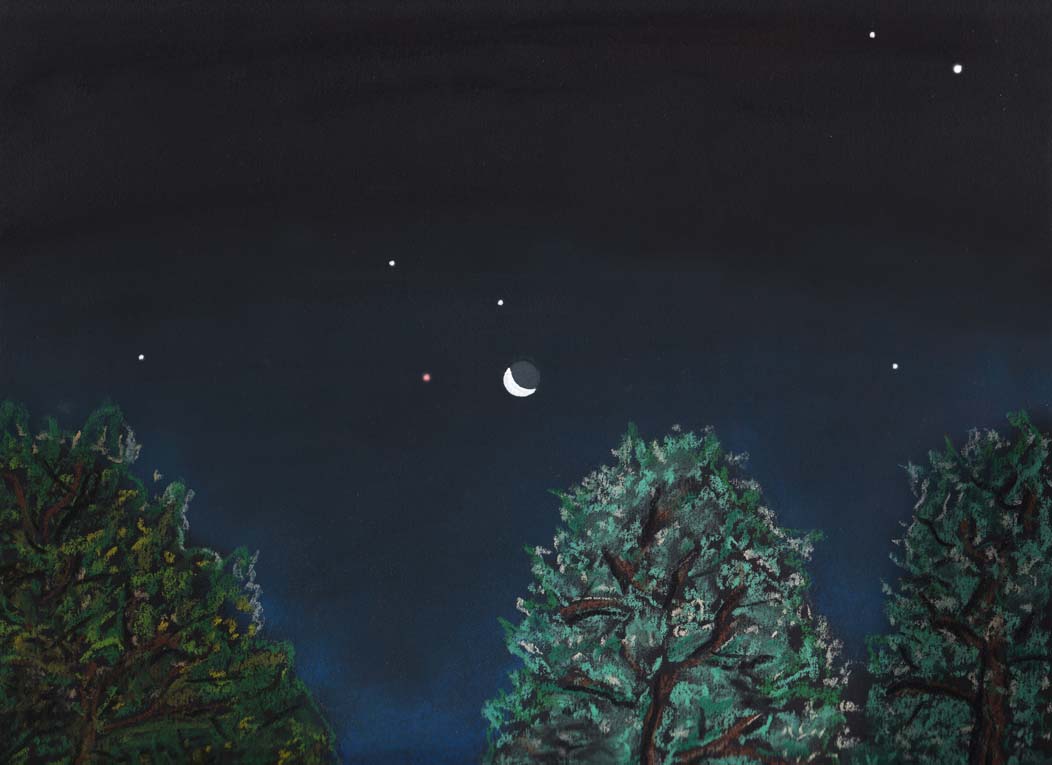
Object Name : night sky
Object Type : Planets, stars and moon
Location : Montréal, Canada
Date: October 29th 2013
Media: pastel, white and pink gel pens on black paper
Unable to sleep I decided to get up early on October 29th. It was 5:00 in the morning and the air was crisp but the sight was absolutely gorgeous. I decided to get my pastels and try my best to represent the ambiance and colors of the scenery. Mars was at the left side of a crescent moon and Jupiter hanging high at the right hand side with Castor and Pollux (Gem)
Jean Barbeau
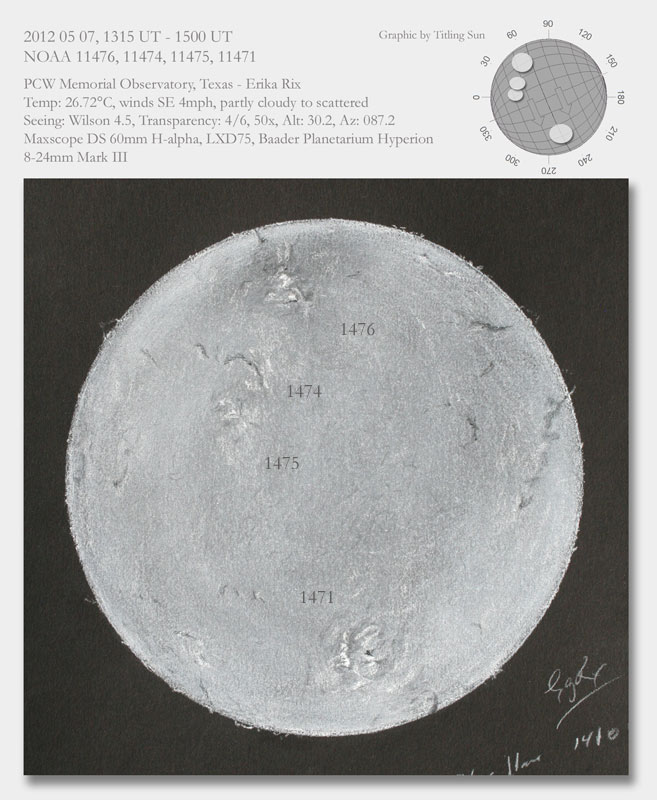
2012 05 07, 1315 UT – 1500 UT.
NOAA 11476, 11474, 11475, 11471.
PCW Memorial Observatory, Texas – Erika Rix
www.pcwobservatory.com
Temp: 26.72°C, winds SE 4mph, partly cloudy to scattered.
Seeing: Wilson 4.5, Transparency: 4/6, 50x, Alt: 30.2, Az: 087.2.
Maxscope DS 60mm H-alpha, LXD75, Baader Planetarium Hyperion 8-24mm Mark III.
Sketches created at the eyepiece with black Strathmore Artagain paper, white Conte’ crayon and pencil, white Prang color pencil, Derwent charcoal pencil, black oil pencil.
I’ve really been enjoying the current set of active regions the past few days. It would be nice to sketch each individual active region as a close up view, but to do that would take several hours. As it was today, I struggled with a group of thick clouds for the first hour of my session. The sky was crystal clear when I set up and I chose to ignore the weather channel for my area stating that we could have thunderstorms at 8 a.m. Thankfully the storms never came…the clouds did. I was able to catch glimpses of the Sun in between the clouds and by 8:45 a.m., the sky was nearly unobstructed.
The first features added to the sketch after the prominences were plage from 1476 and 1471. Next came the sunspots themselves and filamentary structure. By 9:10 a.m. (1410 UT), very bright plage appeared just north of the sunspots in 1471. I haven’t been able to confirm yet if it was a solar flare, having expected possible flare activity in 1476 instead. But it lasted nearly an hour before it dulled somewhat. Near the end of my session, 1471’s plage brightened quite a bit to the eastern side of the major sunspot in that region as well as about five more degrees further east again.
1474 and 1475 paled in comparison to the two major active regions. There were nice filaments and thin plage that made them easy to find.
The large chain of filament reaching to the southern limb was still there, although thinner. Prominences scattered around the limb were insignificant.
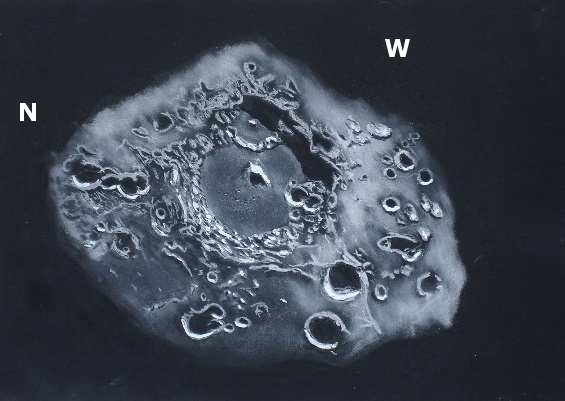
This sketch is centered on the large walled plain crater Albategnius (135 km.). The well illuminated inner and outer rim margins appeared very rugged in contrast to the smooth floor interrupted by the off center mountain casting a large shadow. A sizable portion of the western wall was destroyed by crater Klein (45 km.). Klein also has a central peak which was overtaken by shadow during this observing session. Also visible in the sketch on the eastern side of Albategnius are craters Ritchey (25 km.), Hind (30 km.) and close by Halley (36 km.)
Sketching:
For this sketch I used: black Strathmore 400 Artagain paper, 8”x 12”, white and black Conte’pastel pencils, flat white paint, pink pearl eraser and blending stumps.
Telescope: 10 inch f/5.7 Dobsonian and 6mm eyepiece 241x
Date: 09-26-2013 00:30 – 02:00 UT
Temperature: 15°C (60°F)
Clear, calm
Seeing: Antoniadi III
Co longitude: 165.3°
Lunation: 20.55 days
Illumination: 60.7 %
Phase: 282.3°
Frank McCabe
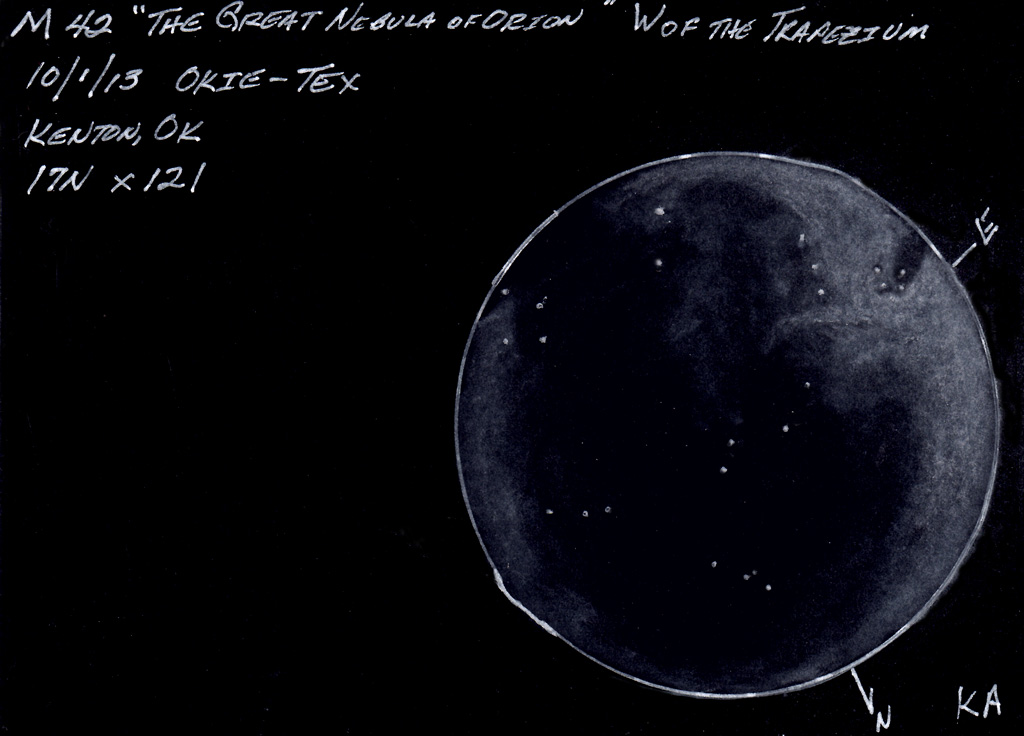
Object : M42 (West of Trapezium)
Object Type: Emission Nebula
Location: Kenton, OK (Okie-Tex Star Party)
Date: 10 October 2013, 0300 MDT
Media: Black paper, conte crayon, pencil and pen
Note: I liked the way the 17mm eyepiece framed this portion of the nebula. It looked, to me, like a wreath.
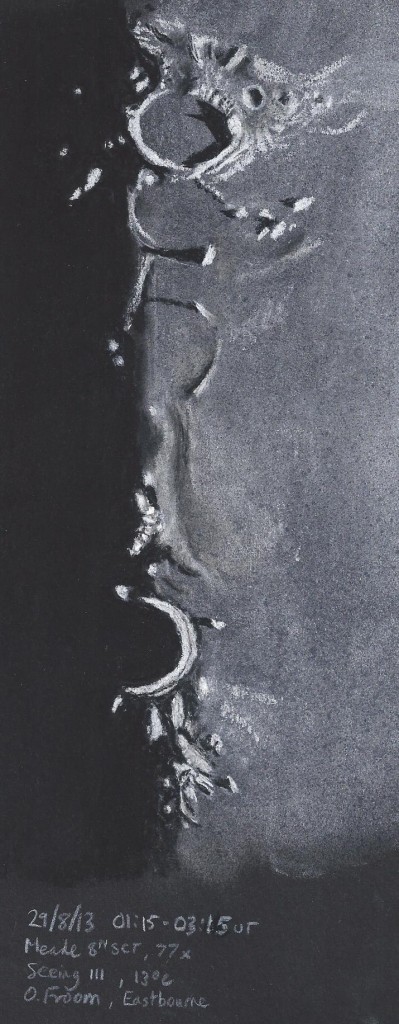
Plato and Archimedes lunar craters
Eastbourne, UK
29th August 2013, 01:15 – 03:15 UT. Temperature 13C; seeing Antoniadi III
Meade LX90 8″ Schmidt-Cassegrain telescope with 26mm super Plossl eyepiece, 77x
White and black pastel on Daler Rowney Canford black paper
I was lucky enough that a second consecutive clear night allowed me to study these craters again; this time they were on the terminator and the whole scene looked very dramatic, enhanced by the long deep shadows.
Best regards and clear skies,
Oli Froom
Zucchius, Schiller and environs
On the evening of September 16, 2013, I got the best view of the basin ring segment between young crater Zucchius (65 km.) and just the tip of large older crater Schiller (179 km.) The ring arc was more than a day beyond the terminator but perfectly illuminated to show its depth and smoothness.
Craters Weigel (36 km.) and Weigel B (37 km.) initially caught my eye as light was brightly glinting off the rims.
For an excellent image of this region see the LPOD for May 26, 2013
http://lpod.wikispaces.com/May+26%2C+2013
There were many fine crater showing nicely in this region at the time of the observation and sketch.
Sketching:
For this sketch I used: black Canson paper 9″x 10″, white and black Conte’
pastel pencils , and Conte’crayons, a blending stump, Pink and White Pearl erasers. Brightness was not altered but contrast was increased +3 using the scanner for this sketch
Telescope: 10 inch f/ 5.7 Dobsonian with 6mm (241x) eyepiece
Date: 09-17-2013, 02:00 – 03:45 UT
Temperature: 16°C (60°F)
Clear, calm
Seeing: Antoniadi II
Co longitude 53.8°
Lunation 11.42 days
Illumination 91.5%
Frank McCabe
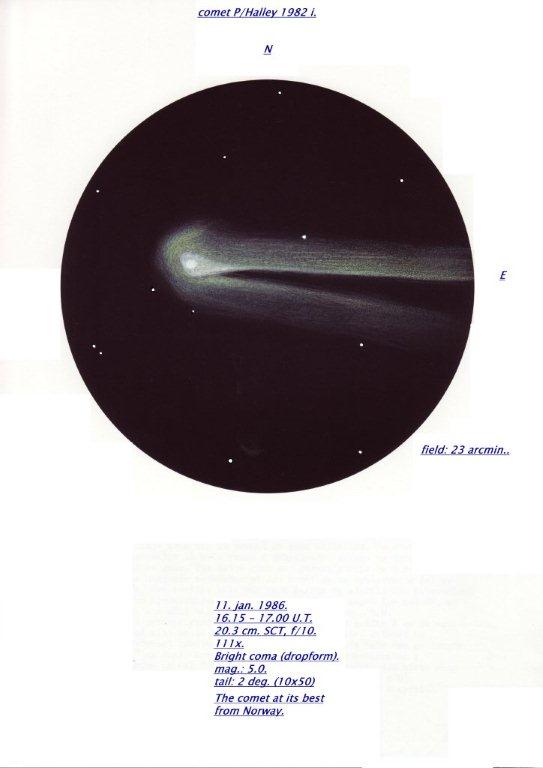
Hey Artists!
My sketch here, shows the famous comet Halley as seen at its best from Norway.
The bright coma had a drop-form, and a halo was seen in the outer coma to west.
In my 10 x 50 binos, the tail was narrow and 2 deg. long. Info on my sketch.
Halley returns in 2061, so good luck to the younger observers!
I used colour crayons on black paper.
Location : Trondheim, Norway.
Best wishes from : Per-Jonny Bremseth.